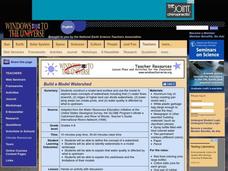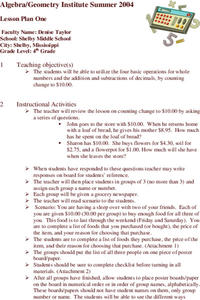Curated OER
Insects A-Z!
Alphabet insects! Who has ever heard of such a thing? Get ready because your class is going to research insects that start with a specific letter of the alphabet. In small groups, they'll use the Internet and reference texts to locate...
Curated OER
Test Your Speaking & Listening Skills: Lucky Dip 2
Sometimes your English language learners don't need structured speaking practice to build oral fluency. This fun trivia worksheet provides them several opportunities to talk. In groups, they must list three countries in Asia, three...
Polar Trec
Calorimetry Lab
Young people between the ages of 11–13 need on average about 2,000 calories per day. Within the lab, groups learn about calorimetry and respiration. They explore how it pertains to humans and animals living the Arctic where cold...
Curated OER
Agriculture Shapes Kentucky History
Students explore the lives of early American Indians and settlers in Kentucky. They describe the agricultural practices of Indians native to Kentucky and develop a supply list for a group of settlers coming to the state to establish...
National Nanotechnology Infrastructure Network
Creating and Testing Silver-Nanoparticle Socks
Antibacterial socks are a product of nanotechnology. An inquiry-based lesson asks collaborative groups to create their own antibacterial socks and then test them against other products on the market. The sock with the least amount...
Curated OER
Test Your Speaking & Listening Skills: Lucky Dip 3
Group your English language learners for this fun trivia exercise. There are 20 questions for each group to discuss. They must name different animals that live in water, recall basic vocabulary terms, recall the capital of Russia, etc....
Curated OER
Build a Model Watershed
Collaborative earth science groups create a working model of a watershed. Once it has been developed, you come along and introduce a change in land use, impacting the quality of water throughout their watershed. Model making is an...
Curated OER
Semipermeable Membranes and Bioaccumulation
Beginning biologists place a drop of food coloring into water of differing temperatures to observe the effect on the diffusion rate. They remove the shells from raw eggs and then experiment with osmosis over the remaining membranes....
Missouri Department of Elementary
Ingredients of a Relationship Recipe
An eye-catching hook makes a smart analogy between ingredients for a food recipe and ingredients for quality relationships. Scholars discuss and list qualities they feel contribute to positive interactions. Pupils create a recipe card...
Curated OER
Microwave Introduction
Middle schoolers take true and false pretest, and explore and practice basic principles of microwave cooking and how to use and care for it properly while preparing foods. Students watch teacher demonstration and then prepare their own...
Curated OER
Nutrition for Kids...and Astronauts
Second graders, in grades 2 and 5, cooperate to create a PowerPoint presentation about nutrition and food. They have a feast culminating the project and invite parents.
Curated OER
Free Enterprise--Product Cost
Students apply basic math skills in computing a product cost.
Curated OER
Food Classification
Students are introduced to classification and some of the difficulties surrounding classification and how classification systems need to be able to adapt and how they may need to be changed when new information is discovered. They...
Curated OER
Nutrition in Me!
Third graders explain the basic healthy eating and physical activity concepts. In this healthy lifestyles lesson, 3rd graders describe two main components of a healthy lifestyle, demonstrate two different types of physical...
Curated OER
Basic Operations With Decimals
Fourth graders solve real life addition and subtraction decimal problems. In groups, they read a real life scenario. They use a newspaper to gather data to solve the situation. Students create a poster containing the justification for...
Curated OER
Food For Heart Challenge
Students use a variety of locomotor motions to obtain different pictures of foods for thieir teams. They must decide if the food is always healthy.
Curated OER
Protein
Learners examine protein, what it is and how it functions in the body. In this protein lesson students study the food pyramid, what a protein is and what it does.
English Linx
Commas Worksheet (Part 1)
One of the basic rules of commas is that they are similar to pauses that occur in speech. This is what this learning exercise practices. The basic rules of commas will have to be reviewed before the page can be issued, but when it is in...
Curated OER
Dinosaurs
Students are introduced to the various types of dinosaurs and write in their journals about their favorite one. After listening to a story and watching a filmstrip, they color a few pages in their Dinosaur Friends Book. They also examine...
Biology Corner
Cell Theory Rap
All that this will link you to is a rap about cell theory and organelles. Use it as an example for a creative assignment in your biology class. Divide the class into groups and assign them a topic for which they write and perform a skit,...
Curated OER
The Biosphere
For this biosphere worksheet, students identify the different levels of organization that ecologists study. Students complete charts, sentences, and answer short answer questions.
Curated OER
Design-A- Meal
Third graders work together to create menus for a fictitious restaurants. As a class, they use them to order a healthy meal and calculate the cost of the meal. They review the food groups on the food pyramid and what it means to have a...
Curated OER
Hunger/ Nutrition
Seventh graders investigate nutrients and nutrition to determine what types of food the body needs for energy. They study each type of nutrient and why it is important to the body. They determine what a balanced diet is by completing the...

























